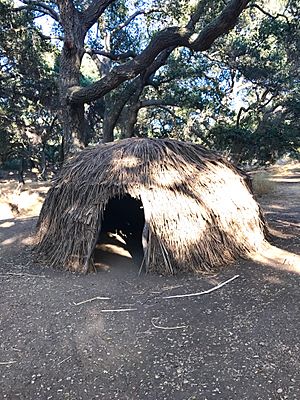Chumash Indian Museum facts for kids
The Chumash Indian Museum is a special place in Thousand Oaks, California, where you can learn about the Chumash people. It's built on the site of an ancient Chumash village called Sap'wi, which means "House of the Deer." People lived here as long as 10,000 years ago!
This museum is part of Oakbrook Regional Park, a big park with 432 acres. Inside the park, you can find a recreated Chumash village and amazing rock paintings, called pictographs, that are thousands of years old. The museum helps keep the history and culture of the Chumash people alive. It was started in 1994 by a group called the Oakbrook Park Chumash Indian Corp.
In 1971, this area became an important archaeological zone after many caves were found. It was later recognized as a historical landmark for Ventura County and the City of Thousand Oaks. The museum has many Chumash artifacts, paintings, and historical items for you to explore. Sadly, the museum grounds were damaged by the 2018 Woolsey Fire, but they have been working hard to recover.
Contents
Ancient Rock Paintings
The museum grounds are home to incredible cave paintings, also known as pictographs. These ancient artworks are found in two rock shelters nearby. Each painting uses red colors and shows different designs.
One of the most famous paintings is a broadbill swordfish. Swordfish were once common in the local ocean waters. For the Chumash, the swordfish was a very special animal, often linked to a spiritual leader called a shaman. These pictographs likely show a Swordfish Shaman's spirit helper. It's believed that swordfish shamanism was practiced here for thousands of years. These paintings are between 4,000 and 6,000 years old! You can see them on special tours led by museum guides.
Museum Exhibits
The Chumash Indian Museum has both indoor and outdoor exhibits that bring Chumash history to life.
Inside the Museum
The indoor part of the museum is about 5,400 square feet. Here, you can see many artifacts found right in the local area. These include tools used for grinding acorns, musical instruments, and traditional games. There are also colorful murals and realistic models of animals like cougars.
One special exhibit is a reconstructed tomol, which is a traditional Chumash canoe. You can also see a diorama that shows what life was like for the Chumash before Spanish explorers arrived. The museum often borrows items from the Santa Barbara Museum of Natural History, such as woven bowls and grinding tools, to share with visitors.
Outside the Museum
Outside, you'll find several gardens and a reconstructed Chumash village. This village shows what Chumash homes, called 'aps, looked like. There's also a traditional Chumash playing field, known as a malamtepupi.
The museum grounds also have miles of hiking trails. Along these trails, you can see a huge oak tree that many believe is the oldest and largest in Thousand Oaks. It has a trunk that's 12 feet wide and a canopy that spreads 60 feet! The area also has 11 archaeological sites along the creek, including more ancient pictographs and bedrock mortars used for grinding food.
Behind the museum, there's a 25-acre nature preserve in a canyon. A shaded trail follows Conejo Creek, passing old oak trees that are 200-300 years old. You'll also see more mortar holes and dramatic rock formations. Some of these rocks have been carved by weather into interesting shapes, like Elephant Rock and Calm Rock.
Ethnobotany Gardens
Near the museum, there are four special gardens called Ethnobotany Gardens. "Ethnobotany" is the study of how people use plants. These gardens show native plants and explain how the Chumash people used them for food, medicine, and tools.
- Riparian/Basketry Garden: This garden features plants that grow near creeks. Many of these plants were important for making baskets and fibers. For example, Basket Rush was a main material for woven baskets, and Horsetail stems were used like sandpaper. The Chumash also ate seeds from Miner's Lettuce and made tea from Yerba Mansa roots.
- Chaparral Garden: Here, you'll find plants from the hillsides, like those in chaparral and coastal sage scrub areas. Many plants here provided food, such as berries from Laurel Sumac and seeds from Lemonadeberry. Wood from the Island Ironwood was used for harpoons and canoe paddles.
- Desert Garden: This garden shows plants that grow in drier areas. You can see plants like Coast Prickly Pear, chia sage, and White Sage. The Chumash ate seeds from plants like Thistle Sage and Chia Sage. They also ate the fruits of the Coast Prickly Pear and used them to make paint.
- Fruits and Flower Garden: Located by the museum entrance, this garden has native plants that produce beautiful flowers or tasty fruits. You'll find plants like California Blackberry, California Wild Rose, and Coast Live Oak. The Coast Live Oak was a key source of acorns, which were a major food for the Chumash. They also ate fruits from many of these plants, like Golden Currant and Gooseberry.
See also





